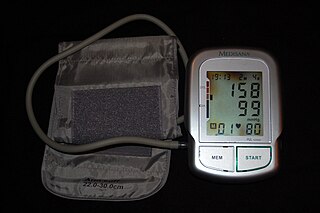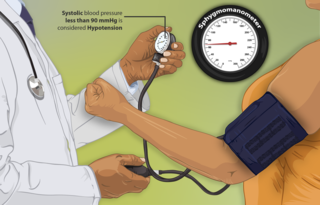
John Henryism is a strategy for coping with prolonged exposure to stresses such as social discrimination by expending high levels of effort, which results in accumulating physiological costs. [1] [2]

John Henryism is a strategy for coping with prolonged exposure to stresses such as social discrimination by expending high levels of effort, which results in accumulating physiological costs. [1] [2]
The term was conceived in the 1970s by African-American epidemiologist and public health researcher Sherman James while he was investigating racial health disparities between Black people and others in North Carolina. [3]
One of the people he interviewed was a Black man, who, despite being born into an impoverished sharecropper family and having only a second grade education, could read and write. The man had freed himself and his children from the sharecropper system, had 75 acres (30 ha) of farmed land by age 40, but by his 50s, he had hypertension, arthritis, and severe peptic ulcer disease. [2]
His name, John Henry Martin, and his circumstances were evocative of folk hero John Henry, an African American who worked vigorously enough to compete successfully with a steam-powered machine but died as a result of his effort. [4] [5]
James' hypothesis was that African Americans sometimes attempted to control their environment through similar attempts at superhuman performance, which may involve working harder at the office or working longer hours to prove one's worth. [3]
James developed a 12-item scale called "The John Henryism Scale for Active Coping" or JHAC12 [6] for measuring this strategy.
The three themes that were deemed important in measuring John Henryism were:
The scale developed for measuring John Henryism was based on agreement with a series of statements such as these: [6]
In his seminal 1983 study, 132 Southern, working-class Black men between the ages of 17 and 60 years were administered the John Henryism scale. The scale was used to measure the extent to which these men believed that they could control their environment through hard work and determination. In accordance with the author's hypothesis, subjects who scored low on educational variables and high on John Henryism had significantly higher levels of diastolic blood pressure than those who scored above the median on both measures.[ contradictory ] James believed that educational achievement and the John Henryism construct score may have a positive correlation with autonomic arousal in African Americans when these individuals have encounters with everyday stressors.
Men who scored higher on the John Henryism scale were not found to have statistically significant differences in mean systolic blood pressure or mean diastolic blood pressure when compared to their lower-scoring counterparts. However, a significant effect did emerge in the variation of the percentage of hypertension. [1] Those who were categorized as low or medium socioeconomic status (SES) and had high levels of John Henryism had a significantly higher percentage of hypertension than their counterparts with low levels of John Henryism. [1] However, high-SES men with high levels of John Henryism were found to have lower levels of hypertension than their low–John Henryism, high-SES counterparts. [1]
African Americans with high John Henryism scores were less likely to be current or former smokers than those with low scores. African-American college students with high John Henryism scores were less likely to have carried a weapon on campus for self-defense, more likely to have been arrested for driving under the influence, and more likely to have missed a class due to alcohol use. [7]

Blood pressure (BP) is the pressure of circulating blood against the walls of blood vessels. Most of this pressure results from the heart pumping blood through the circulatory system. When used without qualification, the term "blood pressure" refers to the pressure in a brachial artery, where it is most commonly measured. Blood pressure is usually expressed in terms of the systolic pressure over diastolic pressure in the cardiac cycle. It is measured in millimeters of mercury (mmHg) above the surrounding atmospheric pressure, or in kilopascals (kPa). The difference between the systolic and diastolic pressures is known as pulse pressure, while the average pressure during a cardiac cycle is known as mean arterial pressure.

Hypertension, also known as high blood pressure, is a long-term medical condition in which the blood pressure in the arteries is persistently elevated. High blood pressure usually does not cause symptoms itself. It is, however, a major risk factor for stroke, coronary artery disease, heart failure, atrial fibrillation, peripheral arterial disease, vision loss, chronic kidney disease, and dementia. Hypertension is a major cause of premature death worldwide.

Korotkoff sounds are the sounds that medical personnel listen for when they are taking blood pressure using a non-invasive procedure. They are named after Nikolai Korotkov, a Russian physician who discovered them in 1905, when he was working at the Imperial Medical Academy in St. Petersburg, the Russian Empire.

A sphygmomanometer, also known as a blood pressure monitor, or blood pressure gauge, is a device used to measure blood pressure, composed of an inflatable cuff to collapse and then release the artery under the cuff in a controlled manner, and a mercury or aneroid manometer to measure the pressure. Manual sphygmomanometers are used with a stethoscope when using the auscultatory technique.

Pre-eclampsia is a multi-system disorder specific to pregnancy, characterized by the onset of high blood pressure and often a significant amount of protein in the urine. When it arises, the condition begins after 20 weeks of pregnancy. In severe cases of the disease there may be red blood cell breakdown, a low blood platelet count, impaired liver function, kidney dysfunction, swelling, shortness of breath due to fluid in the lungs, or visual disturbances. Pre-eclampsia increases the risk of undesirable as well as lethal outcomes for both the mother and the fetus including preterm labor. If left untreated, it may result in seizures at which point it is known as eclampsia.

Hypotension, also known as low blood pressure, is a cardiovascular condition characterized by abnormally reduced blood pressure. Blood pressure is the force of blood pushing against the walls of the arteries as the heart pumps out blood and is indicated by two numbers, the systolic blood pressure and the diastolic blood pressure, which are the maximum and minimum blood pressures within the cardiac cycle, respectively. A systolic blood pressure of less than 90 millimeters of mercury (mmHg) or diastolic of less than 60 mmHg is generally considered to be hypotension. Different numbers apply to children. However, in practice, blood pressure is considered too low only if noticeable symptoms are present.

Pulse pressure is the difference between systolic and diastolic blood pressure. It is measured in millimeters of mercury (mmHg). It represents the force that the heart generates each time it contracts. Healthy pulse pressure is around 40 mmHg. A pulse pressure that is consistently 60 mmHg or greater is likely to be associated with disease, and a pulse pressure of 50 mmHg or more increases the risk of cardiovascular disease. Pulse pressure is considered low if it is less than 25% of the systolic. A very low pulse pressure can be a symptom of disorders such as congestive heart failure.

Afterload is the pressure that the heart must work against to eject blood during systole. Afterload is proportional to the average arterial pressure. As aortic and pulmonary pressures increase, the afterload increases on the left and right ventricles respectively. Afterload changes to adapt to the continually changing demands on an animal's cardiovascular system. Afterload is proportional to mean systolic blood pressure and is measured in millimeters of mercury.
Essential hypertension is a form of hypertension without an identifiable physiologic cause. It is the most common type affecting 85% of those with high blood pressure. The remaining 15% is accounted for by various causes of secondary hypertension. Essential hypertension tends to be familial and is likely to be the consequence of an interaction between environmental and genetic factors. Hypertension can increase the risk of cerebral, cardiac, and renal events.

In medicine, the mean arterial pressure (MAP) is an average calculated blood pressure in an individual during a single cardiac cycle. Although methods of estimating MAP vary, a common calculation is to take one-third of the pulse pressure, and add that amount to the diastolic pressure. A normal MAP is about 90 mmHg.
The Dietary Approaches to Stop Hypertension or the DASH diet is a diet to control hypertension promoted by the U.S.-based National Heart, Lung, and Blood Institute, part of the National Institutes of Health (NIH), an agency of the United States Department of Health and Human Services. The DASH diet is rich in fruits, vegetables, whole grains, and low-fat dairy foods. It includes meat, fish, poultry, nuts, and beans, and is limited in sugar-sweetened foods and beverages, red meat, and added fats. In addition to its effect on blood pressure, it is designed to be a well-balanced approach to eating for the general public. DASH is recommended by the United States Department of Agriculture (USDA) as a healthy eating plan. The DASH diet is one of three healthy diets recommended in the 2015–20 U.S. Dietary Guidelines, which also include the Mediterranean diet and a vegetarian diet. The American Heart Association (AHA) considers the DASH diet "specific and well-documented across age, sex and ethnically diverse groups."
In medicine, systolic hypertension is defined as an elevated systolic blood pressure (SBP). If the systolic blood pressure is elevated (>140) with a normal (<90) diastolic blood pressure (DBP), it is called isolated systolic hypertension. Eighty percent of people with systolic hypertension are over the age of 65 years old. Isolated systolic hypertension is a specific type of widened pulse pressure.
Prehypertension, also known as high normal blood pressure and borderline hypertensive (BH), is a medical classification for cases where a person's blood pressure is elevated above optimal or normal, but not to the level considered hypertension. Prehypertension is now referred to as "elevated blood pressure" by the American College of Cardiology (ACC) and the American Heart Association (AHA). The ACC/AHA define elevated blood pressure as readings with a systolic pressure from 120 to 129 mm Hg and a diastolic pressure under 80 mm Hg, Readings greater than or equal to 130/80 mm Hg are considered hypertension by ACC/AHA and if greater than or equal to 140/90 mm Hg by ESC/ESH. and the European Society of Hypertension defines "high normal blood pressure" as readings with a systolic pressure from 130 to 139 mm Hg and a diastolic pressure 85-89 mm Hg.

Complications of hypertension are clinical outcomes that result from persistent elevation of blood pressure. Hypertension is a risk factor for all clinical manifestations of atherosclerosis since it is a risk factor for atherosclerosis itself. It is an independent predisposing factor for heart failure, coronary artery disease, stroke, kidney disease, and peripheral arterial disease. It is the most important risk factor for cardiovascular morbidity and mortality, in industrialized countries.
Swimming induced pulmonary edema (SIPE), also known as immersion pulmonary edema, is a life threatening condition that occurs when fluids from the blood leak abnormally from the small vessels of the lung (pulmonary capillaries) into the airspaces (alveoli).

Heart failure with preserved ejection fraction (HFpEF) is a form of heart failure in which the ejection fraction – the percentage of the volume of blood ejected from the left ventricle with each heartbeat divided by the volume of blood when the left ventricle is maximally filled – is normal, defined as greater than 50%; this may be measured by echocardiography or cardiac catheterization. Approximately half of people with heart failure have preserved ejection fraction, while the other half have a reduction in ejection fraction, called heart failure with reduced ejection fraction (HFrEF).

Arterial blood pressure is most commonly measured via a sphygmomanometer, which historically used the height of a column of mercury to reflect the circulating pressure. Blood pressure values are generally reported in millimetres of mercury (mmHg), though modern aneroid and electronic devices do not contain mercury.
Hypertensive disease of pregnancy, also known as maternal hypertensive disorder, is a group of high blood pressure disorders that include preeclampsia, preeclampsia superimposed on chronic hypertension, gestational hypertension, and chronic hypertension.
Thomas G. Pickering was a British physician and academic. He was a professor of medicine at College of Physicians and Surgeons, Columbia University Medical Center in New York City. He was an internationally renowned expert in clinical hypertension and a leader in the fields of hypertension and cardiovascular behavioral medicine. He coined the term "white-coat hypertension" to describe those whose blood pressure was elevated in the doctor's office, but normal in everyday life. He later published the first editorial describing "masked hypertension". He also discovered and gave his name to the Pickering Syndrome, where bilateral renal artery stenosis causes flash pulmonary edema.

Labile hypertension occurs when there are unexpected changes in blood pressure. The term can be used to describe when people have blood pressure measurements that abruptly fluctuate from being abnormally high, approximately 140/90mm Hg or over and returns to its normal range.